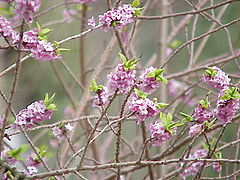Daphne
| {{{name}}} Daphne
|
'
| ||||||||||||||||||||||||||||||||||||||||
|---|---|---|---|---|---|---|---|---|---|---|---|---|---|---|---|---|---|---|---|---|---|---|---|---|---|---|---|---|---|---|---|---|---|---|---|---|---|---|---|---|---|

|
|
| |||||||||||||||||||||||||||||||||||||||
| |||||||||||||||||||||||||||||||||||||||||
| Standard Cyclopedia of Horticulture |
|---|
|
Daphne (Greek name of Laurus nobilis). Thymelaeceae. Ornamental woody plants, chiefly grown for their handsome foliage and sweet-scented, white, purple, lilac or rarely greenish flowers, which, with some species, in warmer climates, often appear in the winter. Low deciduous or evergreen shrubs: Lvs. alternate, rarely opposite, entire, short-petioled: fls. in clusters, short racemes or umbels, apetalous, mostly fragrant; calyx-tube cylindric or campanulate, 4-lobed, corolla-like, usually clothed with silky hairs outside; stamens 8, in two rows, included; stigma capitate, sessile or nearly so: fr. a fleshy or leathery 1-seeded drupe. —About 50 species in Eu. and Asia. For a monograph of the section Daphnanthes see Keissler in Engler Bot. Jahrb. 25:29-124 (1898); see also Nitsche, Beitrage zur Kenntnis der Gattung Daphne (1907). Only D. Mezereum, with very early lilac fragrant flowers and decorative scarlet fruit, and some low evergreen species, like D. Cneorum and D. Blagayana, are hardy North, while most of the evergreen species can be recommended only for warmer climates. D. Genkwa with lilac flowers appearing before the leaves, and D. pontica and D. Laureola, with large evergreen leaves, are hardy as far north as New York. D. odora is fairly hardy in Washington, D. C. In California, according to Franceschi, the species most commonly grown is D. odora, the plants (being mostly imported from Japan. Many plants are also sent from Japan for eastern greenhouse culture. A decoction of the bark of D. Mezereum is sold in drug-stores under the name of mezereum. It is stimulant and diuretic. It is also known as olive spurge. Daphnes thrive best in a well-drained light soil and in a partly shaded position, but some, as D. Cneorum and D. Blagayana, which are exceedingly pretty plants for rockeries, do better in sunny situations. In the North, D. odora and its varieties are often grown in pots for their sweet-scented and handsome flowers appearing during the winter. A sandy compost of peat and loam in equal proportions will suit them; they require a good drainage and careful watering during the winter, and pots not larger than just necessary should be given; they may also be planted out in a cool greenhouse and trained as a wall plant. D. Genkwa, with abundant lilac flowers before the leaves, is sometimes forced. Propagation is by seeds, sown after maturity or stratified, but germinating very slowly; also by layers put down in spring and taken off the following year. The evergreen species may be increased by cuttings of mature wood in fall under glass, and kept in a cool greenhouse during the winter. If gentle bottom heat can be given in early spring, it will be of advantage to the development of the roots; softwood cuttings taken from forced plants may also be used. D. odora is often veneer-grafted on seedling stock of D. Laureola in winter, or on roots of D. Mezereum; also other species are grafted on roots of D. Mezereum. D. Cneorum and probably its allies are readily increased in spring by removing the earth around the plant, pegging down the branches and filling with fine compost almost to the tops of the branches. Next spring, if the compost is carefully removed, a large number of little buds, each supplied with a white root, are found along the branches; they are easily detached and planted in pans or boxes. CH
|
Cultivation
- Do you have cultivation info on this plant? Edit this section!
Propagation
- Do you have propagation info on this plant? Edit this section!
Pests and diseases
- Do you have pest and disease info on this plant? Edit this section!
Species
| Standard Cyclopedia of Horticulture |
|---|
|
{{{1}}} The above text is from the Standard Cyclopedia of Horticulture. It may be out of date, but still contains valuable and interesting information which can be incorporated into the remainder of the article. Click on "Collapse" in the header to hide this text. |
- Selected specieswp
Gallery
If you have a photo of this plant, please upload it! Plus, there may be other photos available for you to add.
Daphne striata in flower
References
- Standard Cyclopedia of Horticulture, by L. H. Bailey, MacMillan Co., 1963


